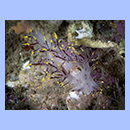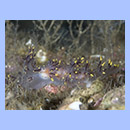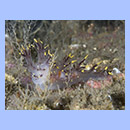- Kingdom: Animalia
- Phylum: Mollusca
- Class: Gastropoda
- Subclass: Heterobranchia
- Order: Nudibranchia
- Suborder: Dexiarchia
- Infraorder: Dendronotida
- Superfamily: Tritonioidea
- Family: Dendronotidae
- Scientific name: Dendronotus sp.
- Norwegian: -
Characteristics:
This specimen had a white, translucent body, 2-3 cm of length. Others have reported of body lengths of 55mm. The pointed, yellow-tipped cerata have a dark magenta gland and there are pigmented blotches in the same color, scattered over the body. It has approximately 18 lamellae on the rhinophores. These features distinguish it from other common Dendronotus species in Norwegian waters:
- D. yrjargul has the same color scheme as this one. The tip of the cerata are heavily fringed and brown pigmentations runs as two lines on the back of the white, translucent body. The rhinophores have 18-30 lamellae. Body lengths up to 10 cm have been observed.
- D. frondosus has between 6 and 12 lamellae on the rhinophores (organ on the top of the head, used to "smell" chemical compounds in the water). The gills are moderately branched, they usually have secondary, but sometimes even tertiary branches. The secondary and tertiary branches have rounded tips. Many specimens have pigmented spots or stripes, but entirely white white, translucent bodies are fairly common, as well.
- D. lacteus has between 10 and 14 lamellae on the rhinophores. The gills tends to be more heavily branched. The tertiary branches are short. The tip of the secondary branches are shaped like spikes, in contrast to the rounded branches of D. frondosus. The color variation is as great as the D. frondosus, but white specimens seems to be common in Trøndelag waters. This is also reported from Sweden, by Thollesson.
- D. robustus has shorter, not so heavily branched gills, compared to the two species above. The flattened, not so slender body gives this species a more robust appearance. It is often heavily pigmented, making the body look reddish brown. White pigmented spots are scattered out over the entire body and tentacles. Close-ups will reveal fine wrinkles in the skin.
Habitat:
It seems to prefer current exposed locations, where it feeds on hydroids.
Distribution:
The distribution of this species is very uncertain. So far I know only of observations from the regions around, the Trondheim fjord.


